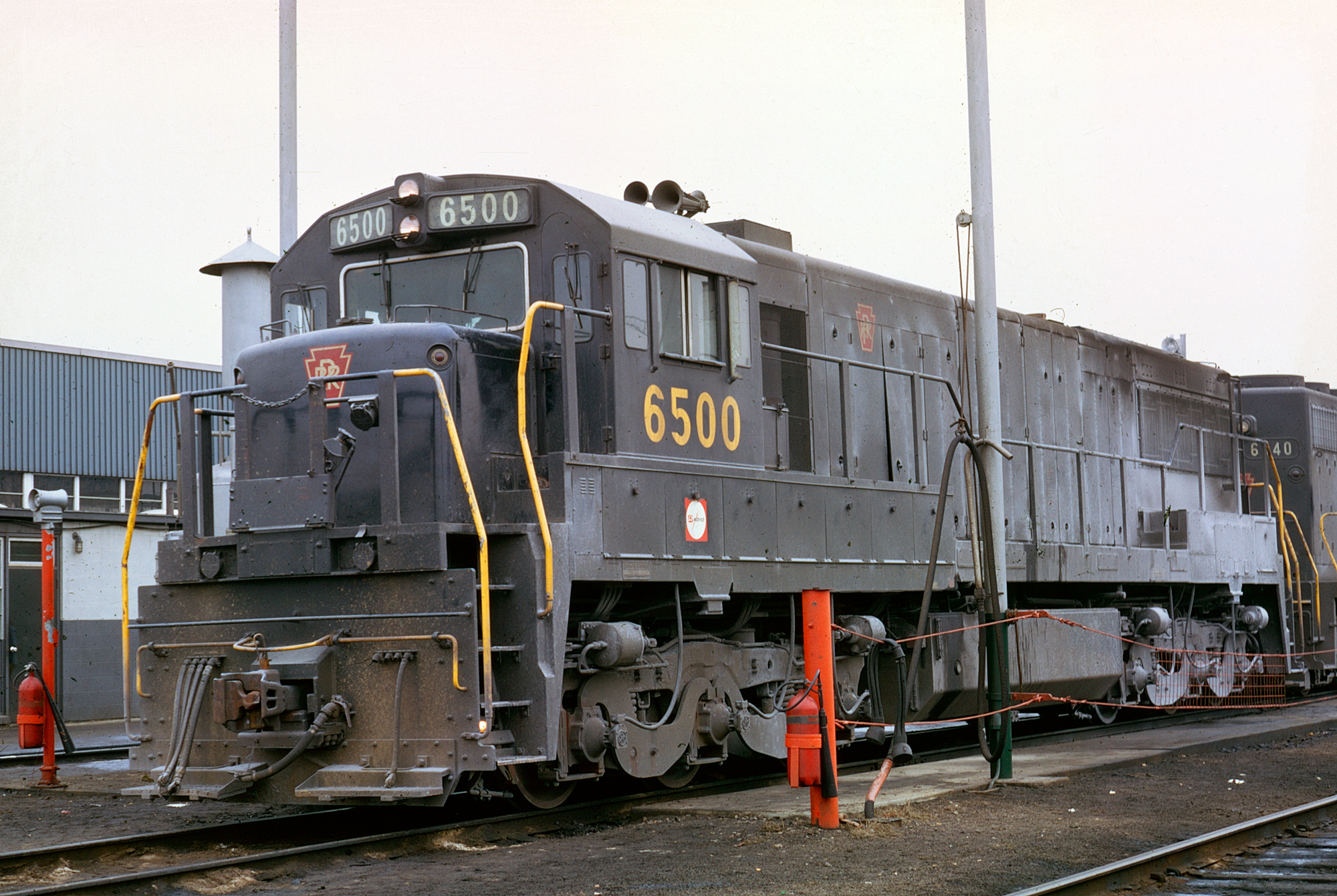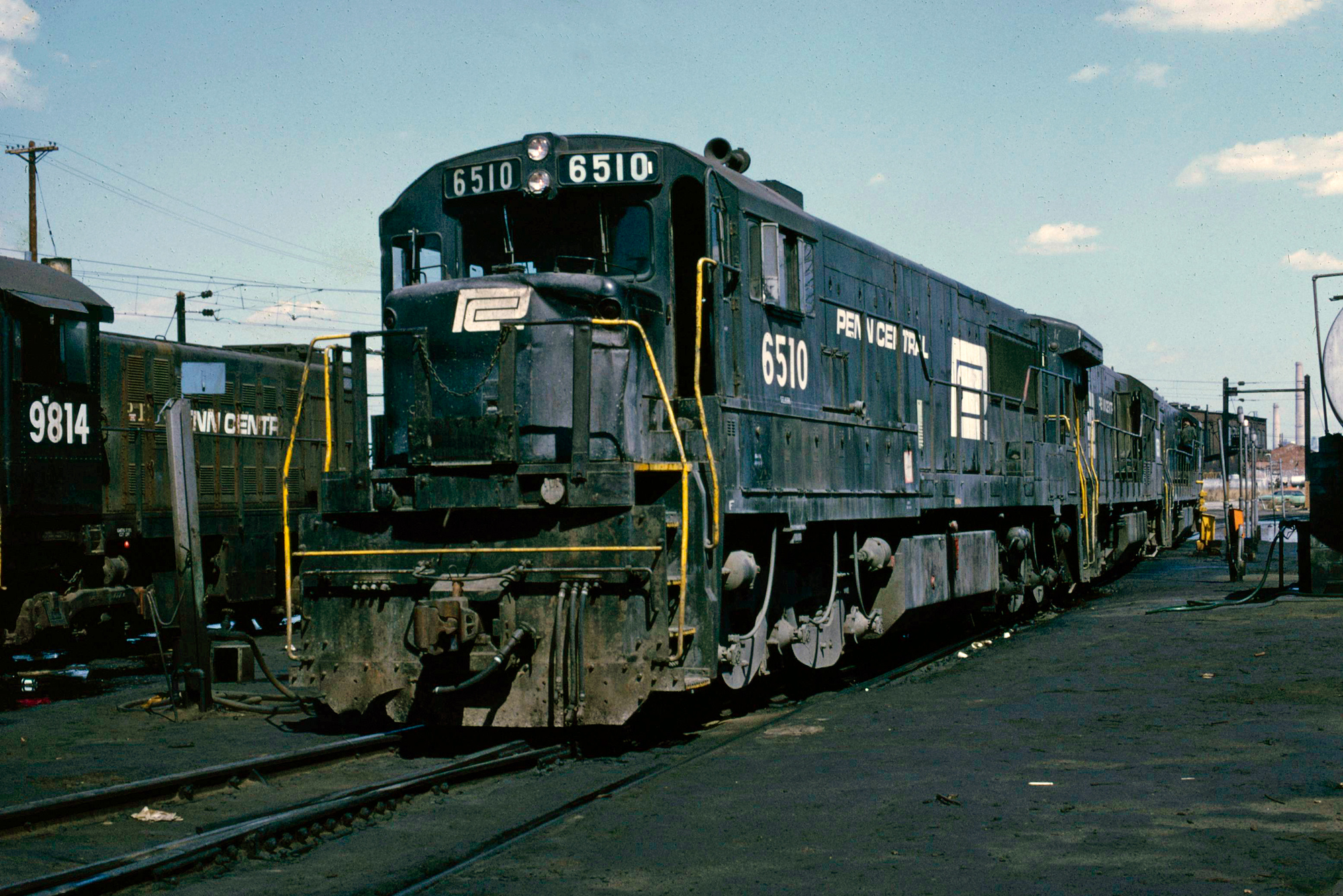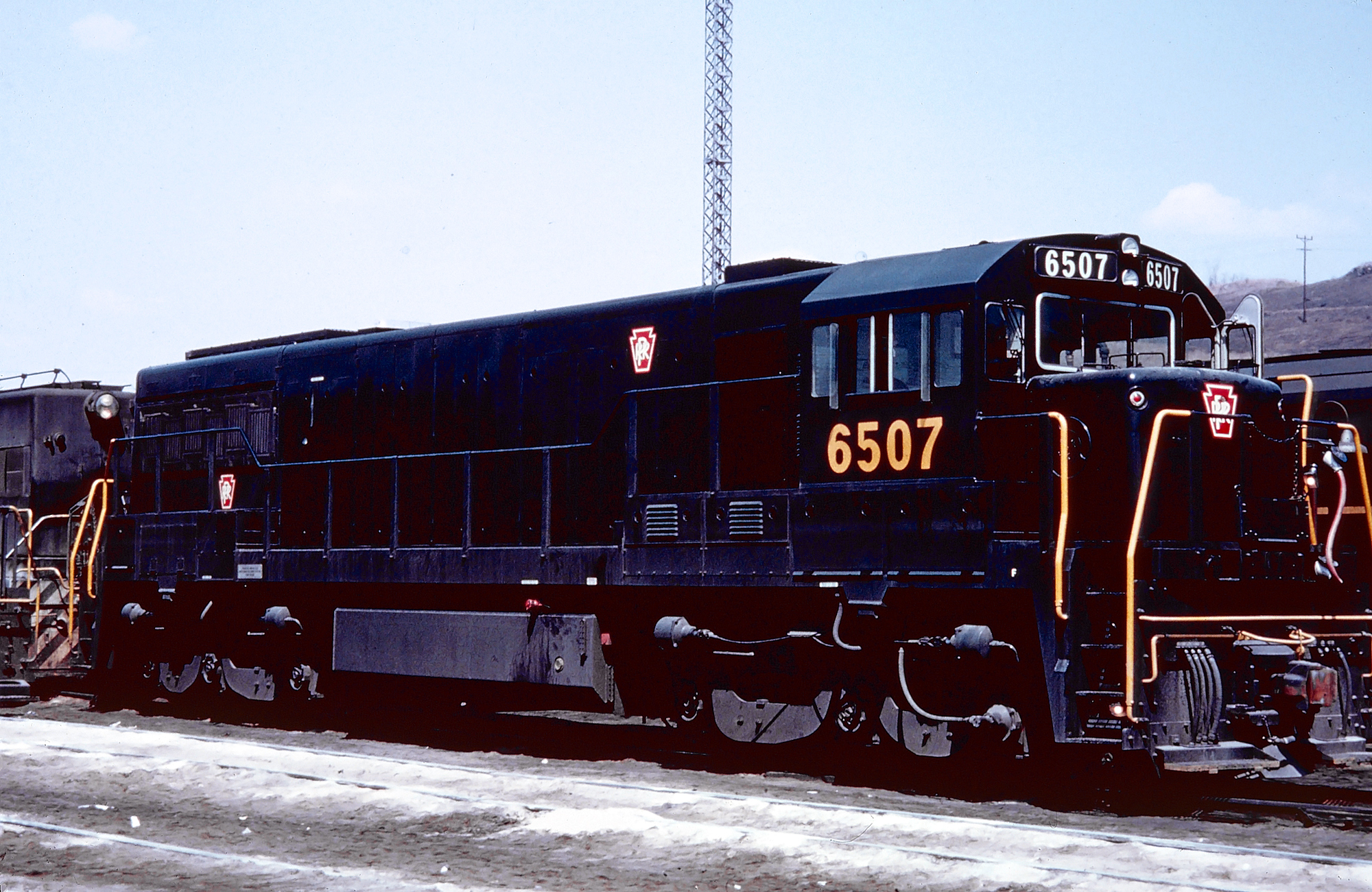GE "U25C" Locomotives: Specs, Roster, History
Last revised: January 1, 2025
By: Adam Burns
The U25C was General Electric's first entry into the six-axle locomotive
market.
The locomotive debuted in 1963 and as Brian Solomon notes in his book, "GE Locomotives," was specifically tailored for heavy freight service during an era before six-motor diesels had gained widespread popularity.
Electro-Motive and American Locomotive had cataloged six-motored variants since the early 1950's and both builders enjoyed little success.
However, sentiment within the industry changed as manufacturers uprated their models to the 3,000 horsepower during the mid-1960's. As a result, railroads began models like the SD35, SD40, U30C, and U33C by the hundreds and thousands.
The combination of high horsepower and high tractive effort proved a winning combination. After the mid-1970s nearly all domestic-built General Electric and EMD models were of the C-C variety.
Photos
 It's the early Penn Central era as a former Pennsylvania U25C, #6500, lays over at Newton, Massachusetts on March 18, 1969. The unit was about four years old in this photo. American-Rails.com collection.
It's the early Penn Central era as a former Pennsylvania U25C, #6500, lays over at Newton, Massachusetts on March 18, 1969. The unit was about four years old in this photo. American-Rails.com collection.History
The U25C entered production in September, 1963; the first units to roll out of Erie were four examples for the Oroville Dam project (#8010-8013).
This project was launched in 1961 to dam the Feather River east of the city of Oroville, California. The earthfill dam was built by the California Department of Water Resources (DWR).
Today, it is part of the California Aqueduct, which provides irrigation for farms in the San Joaquin Valley and supplies drinking water to Southern California.
Ultimately, the project would utilize seven U25C's and had to purchase three additional units following a deadly head-on collision on October 7, 1965 between a train of westbound empties (led by #8010-8011) and eastbound loads (led by #8016 and #8014).
The trains collided at the entrance to one of the construction tunnels causing 10,000 gallons of diesel fuel to ignite and killing four men.
 Penn Central U25C #6510, built as Pennsylvania #6510 in December, 1965, is seen here in Kearny, New Jersey in June, 1975. American-Rails.com collection.
Penn Central U25C #6510, built as Pennsylvania #6510 in December, 1965, is seen here in Kearny, New Jersey in June, 1975. American-Rails.com collection.At the time of the U25C's production most railroads remained hesitant to use six-motored locomotives in main line applications.
While GE saw lower sales of the U25C by comparison to its four-axle counterpart the builder still managed to sell 113 examples to a variety of railroads.
The U25C utilized GE's 4-cycle model 7FDL16 prime mover and could produce 2,500 horsepower. The classification for the GE's six-axle designs followed the premise of its original four-axle variant.
For instance, in the case of the U25C:
- "U" regarded the Universal line
- "25" was the first two digits of its horsepower rating, and
- "C" described its powered six-axle trucks (C-C)
All of the locomotive's internal equipment including main/auxiliary generators and traction motors were designed and manufactured by General Electric while air equipment was supplied from Westinghouse Electric.
Reception
The most noticeable benefit of the U25C was its starting tractive effort rating of 90,000 pounds, nearly 17% higher than with the U25B.
This allowed it to get heavier trains started faster than its four-axle cousin. While railroads were still reluctant to purchase six-motored locomotives, this sentiment changed when upgraded electrical components enabled traction motors to catch up with the prime movers and produce 3,000 horsepower.
GE would go on to sell many more examples of its more powerful U30C, U33C, and U36C (combined, these models would sell well over 1,000 examples).
Data Sheet
| Entered Production | 9/1963 (Oro Dam #8010-8013) |
| Years Produced | 9/1963 - 12/1965 |
| GE Class | U25C |
| Engine | 7FDL16 (16 cylinder) |
| Engine Builder | General Electric |
| Horsepower | 2500 |
| RPM | 1050 |
| Length | 64' 6" |
| Height (Top Of Rail To Top Of Cab) | 14' 7" |
| Width | 9' 11" |
| Weight | 348,000 Lbs |
| Fuel Capacity | 1,700 or 2,900 Gallons |
| Air Compressor | 3CDC (Westinghouse) |
| Air Brake Schedule | 26L (Westinghouse) |
| Trucks | C-C |
| Truck Type | Trimount/Adirondack |
| Truck Wheelbase | 13' 0" |
| Wheel Size | 40" |
| Traction Motors | 752 (6), GE |
| Traction Generator | GT598, GE |
| Auxiliary Generator | GY27, GE |
| MU (Multiple-Unit) | Yes |
| Dynamic Brakes | Optional |
| Gear Ratio | 74:18 |
| Tractive Effort (Starting) | 92,000 Lbs |
| Tractive Effort (Continuous) | 60,000 Lbs at 10.7 mph |
| Top Speed | 70 mph |
Production Roster
| Owner | Road Number | Serial Number | Order Number | Completion Date | Quantity |
|---|---|---|---|---|---|
| Oro Dam | 8010-8013* | 34815-34818 | 1800 | 9/1963 | 4 |
| Oro Dam | 8014-8016* | 34819-34821 | 1800 | 3/1964 | 3 |
| Atlantic Coast Line | 3000-3003 | 34969-34972 | 1810 | 12/1963 | 4 |
| Northern Pacific | 2500-2514 | 35035-35049 | 1821 | 5/1964-6/1964 | 15 |
| Pennsylvania | 6504-6509 | 35050-35055 | 1850 | 4/1965 | 6 |
| Pennsylvania | 6503 | 35056 | 1850 | 4/1965 | 1 |
| Pennsylvania | 6500-6502 | 35057-35059 | 1850 | 4/1965 | 3 |
| Lake Superior & Ishpeming | 2500 | 35062 | 1823 | 5/1964 | 1 |
| Lake Superior & Ishpeming | 2501 | 35063 | 1825 | 7/1964 | 1 |
| Atlantic Coast Line | 3004-3010 | 35064-35070 | 1845 | 11/1964 | 7 |
| Louisville & Nashville | 1500-1501 | 35545-35546 | 1855 | 5/1965 | 2 |
| Louisville & Nashville | 1502-1511 | 35548-35557 | 1855 | 5/1965-7/1965 | 10 |
| Louisville & Nashville | 1512 | 35547 | 1855 | 5/1965 | 1 |
| Louisville & Nashville | 1513-1517 | 35558-35562 | 1855 | 10/1965 | 5 |
| Oro Dam | 8017-8018* | 35563-35564 | 1896 | 12/1965 | 2 |
| Northern Pacific | 2515-2529 | 35582-35596 | 1847 | 5/1965-7/1965 | 15 |
| Chicago, Burlington & Quincy | 550-561 | 35597-35608 | 1875 | 8/1965-9/1965 | 12 |
| Atlantic Coast Line | 3011-3013** | 35609-35611 | 1875 | 11/1965 | 3 |
| Atlantic Coast Line | 3014-3020 | 35612-35618 | 1875 | 10/1965-11/1965 | 7 |
| Pennsylvania | 6510-6519 | 35619-35628 | 1895 | 11/1965-12/1965 | 10 |
| Oro Dam | 8019* | 35629 | 1896 | 12/1965 | 1 |
* Oro Dam #8010 and #8011 were involved in a head-on collision with #8016 and #8014 on October 7, 1965. #8010 and #8016 were scrapped in December that year while #8011 was rebuilt by Western Pacific's Sacramento Shops in June, 1966 and became #8020.
#8014 was also rebuilt and returned to service. #8017-8019 were purchased as replacements for the wrecked units. Louisville & Nashville ultimately acquired all of the Oro Dam U25C's in October, 1967. They became L&N #1518-1525.
** Rated at 2,800 horsepower.
Sources
- Foster, Gerald. A Field Guide To Trains. New York: Houghton Mifflin, 1996.
- Marre, Louis A. Diesel Locomotives: The First 50 Years, A Guide To Diesels Built Before 1972. Milwaukee: Kalmbach Publishing Company, 1995.
- McDonnell, Greg. U-boats. Toronto: Stoddart Publishing, 1994.
- Pinkepank, Jerry A. Diesel Spotter's Guide. Milwaukee: Kalmbach Publishing Company, 1967.
- Solomon, Brian. GE Locomotives: 110 Years Of General Electric Motive Power. St. Paul: MBI Publishing, 2003.
 Recently delivered Pennsylvania U25C #6507 is seen here in Conway, Pennsylvania in April, 1965. Fred Byerly photo. American-Rails.com collection.
Recently delivered Pennsylvania U25C #6507 is seen here in Conway, Pennsylvania in April, 1965. Fred Byerly photo. American-Rails.com collection.During the course of production, GE never implemented external improvements to the carbody as it had done with the U25B when the single-piece windshield (expensive to replace) was given a split windshield.
However, a few late-era U25C's, notably Atlantic Coast Line #3011-3013, were uprated to 2,800 horsepower which ushered in the U28C.
Today, at least one U25C is known to be extant; Lake Superior & Ishpeming #2501 on display at the Presque Isle Ore Dock in Marquette, Michigan.
Recent Articles
-
Pennsylvania Father's Day Train Rides: A Complete Guide
May 11, 25 11:14 PM
This state offers a unique way to celebrate Father's Day with unforgettable train rides that combine history, stunning landscapes, and a dash of nostalgia. -
New York Father's Day Train Rides: A Complete Guide
May 11, 25 03:57 PM
If you’re looking to make this day memorable, consider taking a scenic train ride with your dad through the beautiful landscapes of New York State. -
Missouri Father's Day Train Rides: A Complete Guide
May 11, 25 02:57 PM
If you're looking for a unique way to honor your dad this year, why not consider a scenic and historical train ride?


